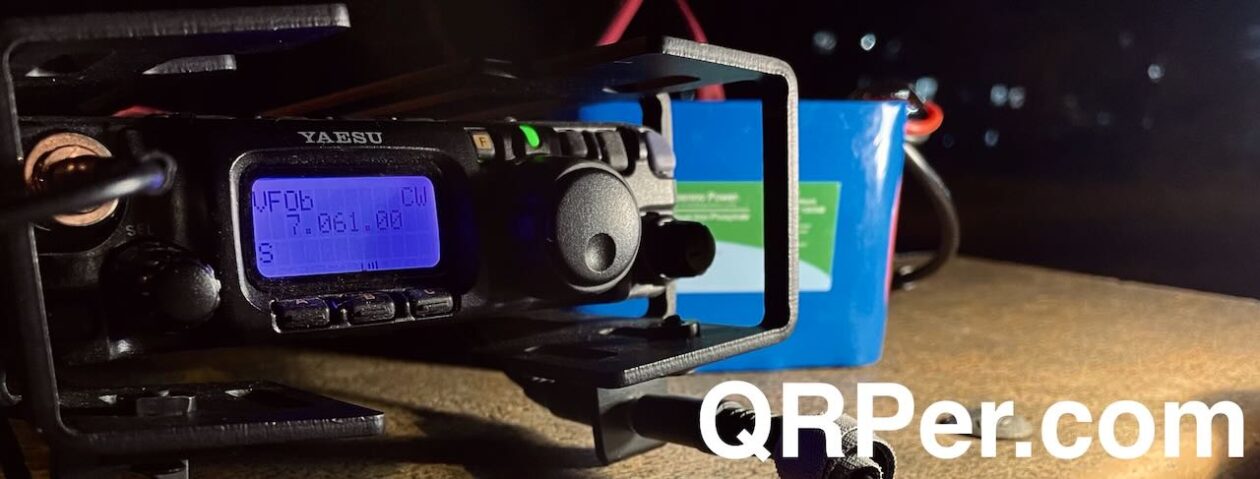Yesterday morning, around 12:00, I picked up a DHL parcel containing the Venus SW-6B. I was so eager to test it in the field that I dropped my lunch plans, took the SW-6B home, opened the box, and quickly attached Anderson Powerpole connectors to the supplied power cable.
I didn’t have time to do anything else, not even turning on the radio.
After doing some back-of-the-envelope calculations, I realized that if I skipped catching up on my email backlog (sorry!), and instead jumped in the car, I could fit in a one-hour activation on the way to visit my dad in Hickory, NC, that afternoon.
Not wanting to compete for the one picnic table at the South Mountains State Park Clear Creek access (the fastest detour), I decided to head instead to the Lake James State Park Catawba River Access en route. There are plenty of site options at Lake James, and mid-afternoon on a Tuesday, I knew it wouldn’t be crowded.
Lake James State Park (US-2739)
 The weather was absolutely beautiful, and I was right: there were very few people at Lake James.
The weather was absolutely beautiful, and I was right: there were very few people at Lake James.
I left the QTH in such a hurry that I didn’t have time to gather all the components for the SW-6B field setup. Instead, I grabbed my SOTA backpack (which should, in theory, have an antenna, cable assembly, throw line/weight, key, and other necessary adapters and accessories).
I found a picnic table with plenty of antenna deployment options (i.e., trees!).
 Luck was on my side, too: my first throw of the throw line made a perfect arc into a tree, giving my 40-meter end-fed half-wave an ideal configuration.
Luck was on my side, too: my first throw of the throw line made a perfect arc into a tree, giving my 40-meter end-fed half-wave an ideal configuration.
 While deploying the antenna, a groundskeeper nearby started mowing a patch of grass with possibly the noisiest mower I’ve ever heard.
While deploying the antenna, a groundskeeper nearby started mowing a patch of grass with possibly the noisiest mower I’ve ever heard. 
As I mention in the video, this is just the kind of QRM you should expect at a good park. The grounds at NC parks are truly outstanding, which takes a lot of work, and I’m very appreciative. It was just a minor inconvenience.
SW-6B Setup
 After deploying the antenna, I set up the SW-6B and spent some time in the video (below) explaining the front panel controls.
After deploying the antenna, I set up the SW-6B and spent some time in the video (below) explaining the front panel controls.
I noted in the video that I purchased one of the very first production models listed on the Venus website.
There are a few options available: a metal case, a plastic case, and with or without an internal battery pack.
 At the time, Dale (BA4TB) only had the metal case version built, so that’s what I ordered, with an internal battery. It’s the priciest option. The total cost, including DHL shipping to the US, was $344.30.
At the time, Dale (BA4TB) only had the metal case version built, so that’s what I ordered, with an internal battery. It’s the priciest option. The total cost, including DHL shipping to the US, was $344.30.
The metal case is very basic. One downside is that it doesn’t have a positive latch—there’s no easy way to secure the lid. For example, if you turn it upside down, it will open. The plastic version has latches—knowing this, I would have much preferred the plastic case.
That said, the metal case has a lot of charm. I plan to secure it with an elastic band or see if I can adapt mine to a plastic case later.
 The internal battery didn’t come fully charged, of course, but it showed 11.3V, which is well within the SW-6B’s voltage range. Knowing this would be a short activation, I opted to use the internal battery instead of grabbing my (comically large, compared to the SW-6B) 15Ah battery from the car.
The internal battery didn’t come fully charged, of course, but it showed 11.3V, which is well within the SW-6B’s voltage range. Knowing this would be a short activation, I opted to use the internal battery instead of grabbing my (comically large, compared to the SW-6B) 15Ah battery from the car.
After turning on the radio, I was pleased to find that the internal speaker provided plenty of amplification for field operations.
It was time to get the SW-6B on the air!
Gear:
 Note: All Amazon, CW Morse, ABR, Chelegance, eBay, and Radioddity links are affiliate links that support QRPer.com at no cost to you.
Note: All Amazon, CW Morse, ABR, Chelegance, eBay, and Radioddity links are affiliate links that support QRPer.com at no cost to you.
- Venus SW-6B metal case version with internal battery
- ABR Industries 25’ RG-316 cable assembly with three in-line ferrites (Use Coupon Code ABR10QRPER for 10% Discount!)
- ABR Industries Cable Assembly Builder (Use Coupon Code ABR10QRPER for 10% Discount!)
- Koh-I-Noor 2.0 mm Mechanical Pencil
- MW0SAW end-fed half-wave
- K6ARK 3D Printed Paddles
- Key cable: Cable Matters 2-Pack Gold-Plated Retractable Aux Cable – 2.5 Feet
- NEMO Resolve 25L backpack (my SOTA pack)
- Red Oxx Hound
- Weaver arborist throw line/weight and storage bag
- Rite In The Rain Top Spiral Notebook
- Camera: DJI OSMO 4 action camera with Joby Telepod Sport Tripod
- Nemo Chipper Foam Seat
On the Air
 I started calling CQ POTA on the 20-meter band and quickly discovered that propagation was unstable.
I started calling CQ POTA on the 20-meter band and quickly discovered that propagation was unstable.
That said, for the first time ever, my first three contacts were all Canadians: VA3NU, VA2CT, and VA2IDX. Nice! Continue reading The New Venus SW-6B QRP Transceiver: First POTA Activation and Field Test!


































































































